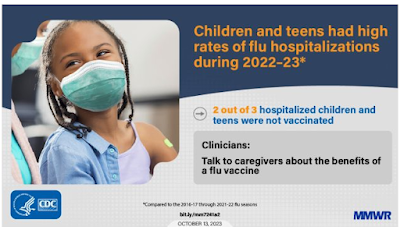
#17,735
As reported yesterday in CDC HAN Advisory #00499: Limited Availability of Nirsevimab in the United States, recent surveillance indicates the rate of RSV infection continues to pick up across the nation, while at the same time we are seeing a shortage of a recently approved monoclonal antibody product for use in infants and toddlers.
These presentations are often technical, and are of greatest interest to clinicians and healthcare providers, but also may be of interest to the general public. As always, If you are unable to attend the live presentation, these (and past) webinars are archived and available for later viewing at this LINK.Against this backdrop, tomorrow the CDC will hold a 1-hour webinar for clinicians on preventing severe RSV disease in infants, including guidance on the administration of RSV immunizations to infants and pregnant people during weeks 32 through 36 of pregnancy.
Details follow, after which I'll have a brief postscript:
Protecting Infants from Respiratory Syncytial Virus (RSV)= Free Continuing Education
Overview
Respiratory syncytial virus (RSV) is a common respiratory virus that usually causes mild, cold-like symptoms but can also affect the lungs. While most children recover from an RSV infection in a week or two, RSV infection can be dangerous for infants and some young children, causing difficulty breathing, low oxygen levels, and dehydration. RSV is the leading cause of infant hospitalizations in the United States. The Centers for Disease Control and Prevention (CDC) recommends two new immunizations to prevent severe RSV disease in infants and older babies.
During this COCA Call, presenters will give a comprehensive overview of CDC’s new recommendations to prevent severe RSV disease in infants, including clinical guidance and considerations for administering RSV immunizations to infants and pregnant people during weeks 32 through 36 of pregnancy.
Presenters
Sarah Meyer, MD, MPH
Chief Medical Officer
Immunization Services Division
National Center for Immunization and Respiratory Diseases
Centers for Disease Control and Prevention
Jefferson Jones, MD, MPH
Co-Lead, ACIP RSV Maternal-Pediatric Work Group
Coronavirus and Other Respiratory Viruses Division
National Center for Immunization and Respiratory Diseases
Centers for Disease Control and Prevention
2:00 PM – 3:00 PM ET
Call Materials
Not available at this time. Please check back.
Call Details
When:
Thursday, October 26, 2023
2:00 PM – 3:00 PM ET
Webinar Link:
https://www.zoomgov.com/j/1600578610
Webinar ID: 160 057 8610
Passcode: 189293
Telephone:
+1 669 254 5252, or,
+1 646 828 7666#
l
International numbers
Six weeks ago, in CDC 2023-2024 Respiratory Disease Seclinical guidance and considerations for administering RSV immunizations to infants and pregnant people during weeks 32 through 36 of pregnancy.ason Outlook, we looked at the CDC's `pre-season' forecast for the upcoming fall and winter respiratory season. While `flu' seasons are notoriously `unpredictable', over the past few years some progress has been made in this endeavor (see CDC About Flu Forecasting).
While expressing only low-to-moderate confidence in this early assessment, last month the CDC predicted the 2023-2024 winter season could produce a `. . . similar number of total hospitalizations compared to last year.'Last year children were particularly hard hit with a recent MMWR report stating 2022-2023 was `. . . classified as high severity among children and adolescents, the fourth season with that classification since the 2009 influenza A(H1N1) pandemic.'
We'll obviously have to wait to see how this year's forecast pans out, but already we are seeing reports of an early arrival of flu in some countries and some hints we could be looking at an H1N1 dominant season - the first since 2019-2020.
Add in the continued arrival of new COVID variants, a (thus far) low uptake of the new COVID vaccine, combined with other respiratory viruses like RSV, and you have the ingredients for what could be a challenging fall and winter ahead.
Stay tuned.

